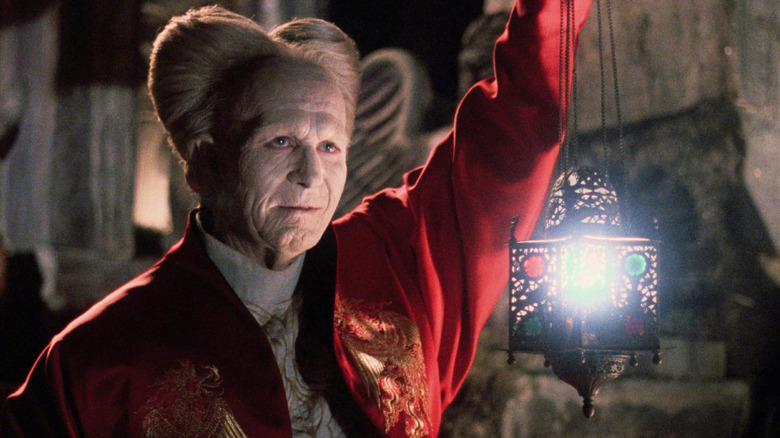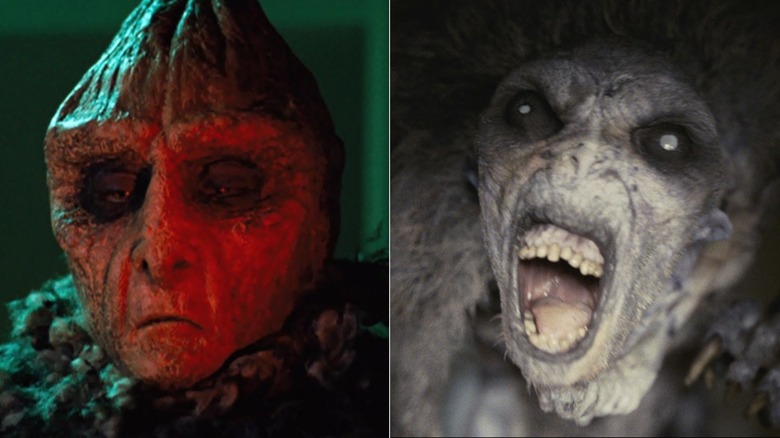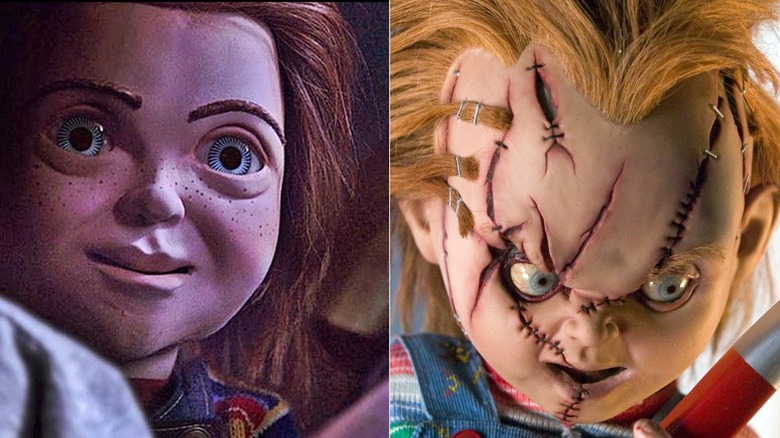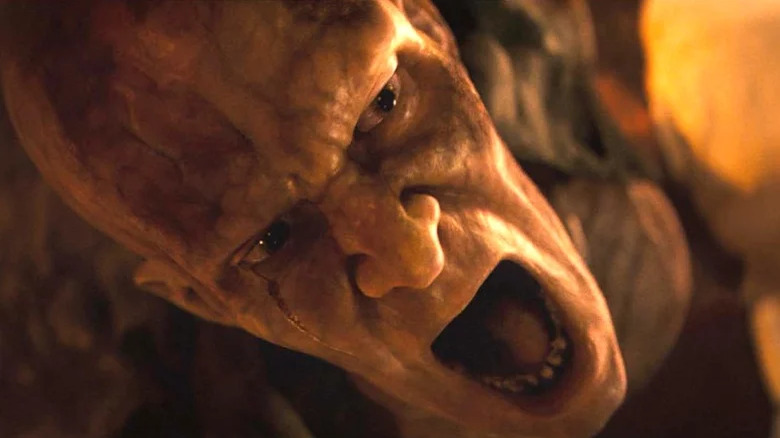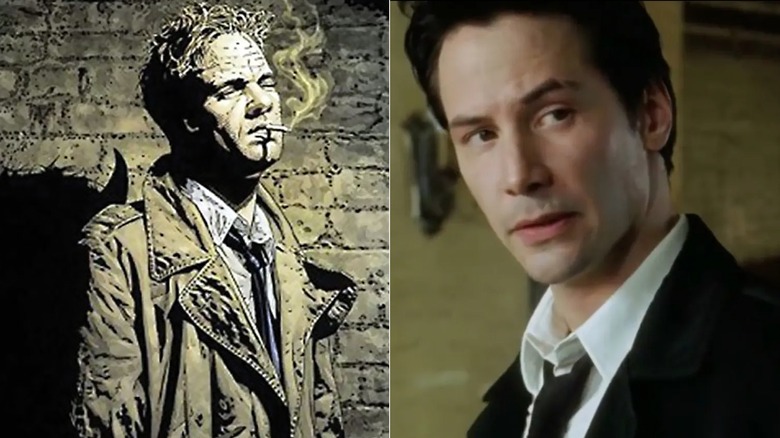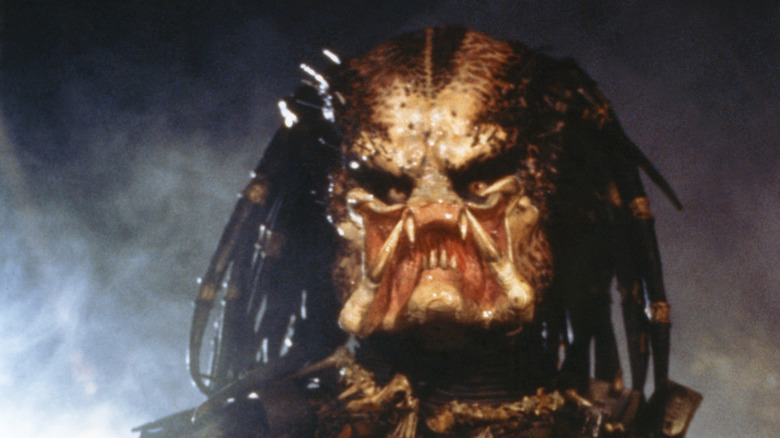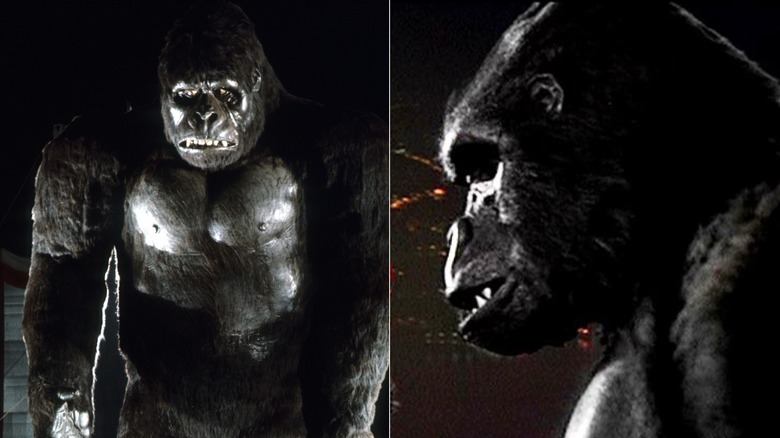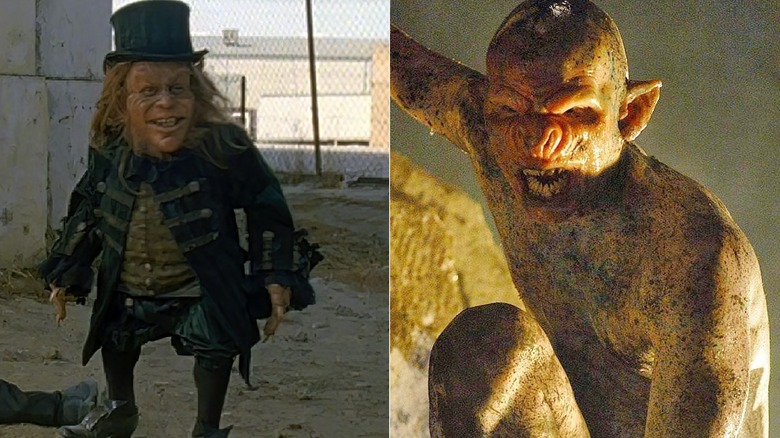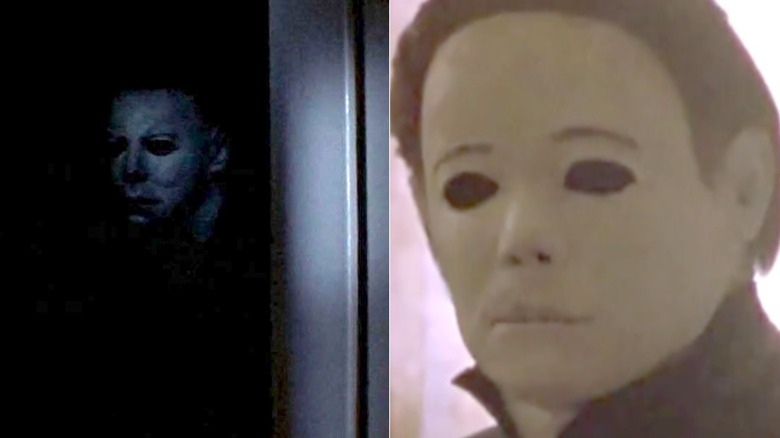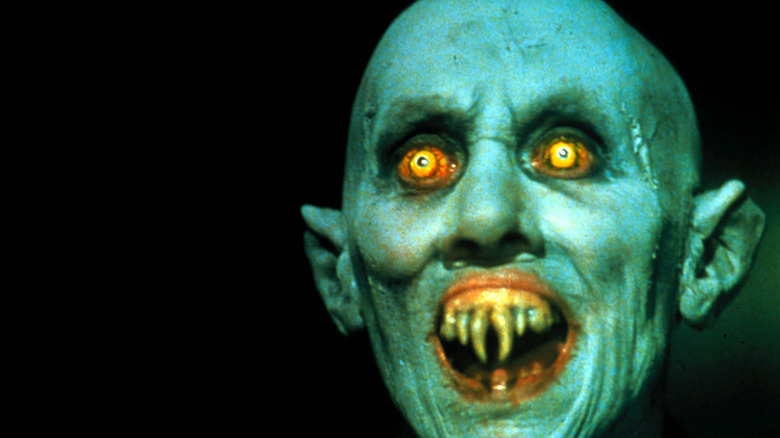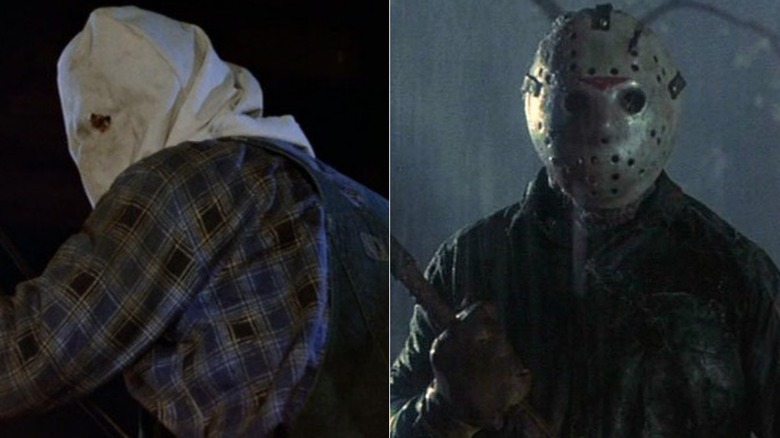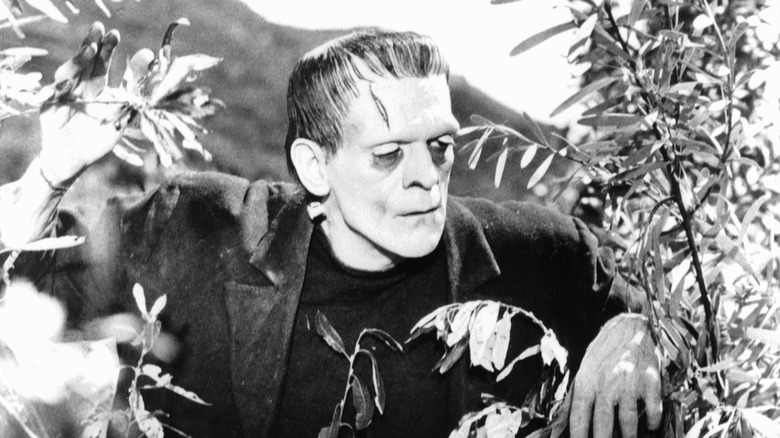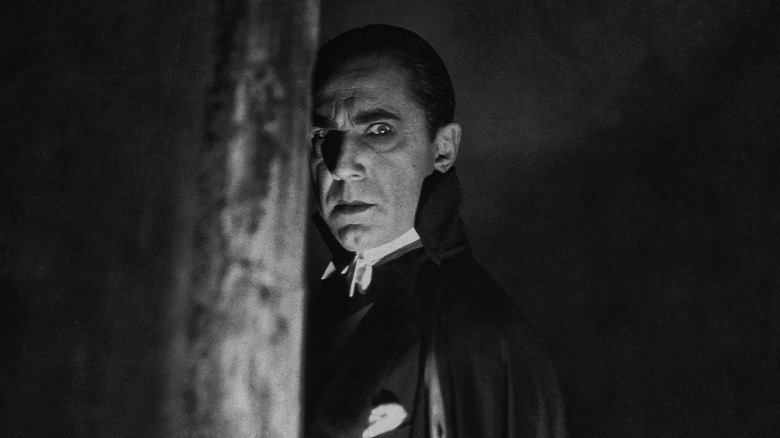The 12 Most Controversial Costume Changes In Horror Movie History
When it comes to costume changes in horror movies, the term is a little more elastic than merely an actor obtaining a different wardrobe. A "costume" in a horror movie might refer to full-body latex or an animatronic suit to completely transform an actor's physicality. It could mean a character goes from being an actor in an outfit to a CG creation. Or it may address the fact that, in adapting non-filmic source material, changes had to be made for the camera, or were made by editorial decision.
Whether it be between installments of a franchise, or from original to remake, or from costume to special effect and vice versa, audiences do not embrace every change. And in some cases, even if most people like a change, purists remain unconvinced. Horror movies, novels, and comics leave indelible images in our minds, so when a newer version "re-skins" them, so to speak, we harbor strong opinions.
Here are 12 changes that spawned some of the strongest.
12. Don't Be Afraid of the Dark
Many a child of the '70s got spooked by this terrifying TV movie about goblin-like creatures who hide in the dark corners of a house, driving its owner mad before finally dragging her into the basement and turning her into one of them. The surprisingly downbeat ending and the creep factor of the monsters, played by little-person actors Felix Silla, Tamara De Treaux, and Patty Maloney, left an impression, and the practical creature costumes, half-glimpsed in shadows, remained burned in the brain.
One such child was Guillermo del Toro, who co-wrote and produced the 2010 theatrical remake. Despite an R-rating and bigger stars like Guy Pearce and Katie Holmes, it's less remembered than the original, largely because the 1973 actors in costumes proved way more terrifying than small CG creatures that looked like mole rats and behaved like evil tooth fairies. As the original movie strongly suggested, some things are better left alone.
11. Chucky
Due to an unusual split-rights situation — MGM owns the rights to the first "Child's Play" movie, while Universal owns all the sequels — Chucky the killer doll became the first of the major '80s slasher villains to get a remake at the same time as his original continuity remained actively ongoing. While creator Don Mancini continued the sequels' narrative via the "Chucky" TV show, MGM remade the original film, with a different take. Rather than a talking doll possessed by a serial killer through a voodoo spell, the new Chucky would be an interactive AI toy called Buddi, with its programming safeguards removed.
Chucky is often a puppet when seen onscreen in any form, but in most of the originals, he's a little person in a costume for at least a few shots. The electronic remake, which many fans commented looked like a cheap knockoff of the original, seems to have always been an effect rather than a person in a suit. As for controversy, Mancini and many of his cast and crew refused to be involved in any way, upset that a loophole allowed someone else to create a different version. Reviews somehow managed to skew positive, but in the end, the creator-owned TV series, with its bizarre twists, clever usage of the original cast, and strongly positive LGBT storylines, won the popularity contest.
Director Lars Klevberg is still game to sequelize the remake, but not necessarily optimistic that he'll get to do so.
10. I Am Legend
In Richard Matheson's novel "I Am Legend," vampires populate the world. Some, who are reanimated undead, look like stereotypical vampires, while others, infected while alive, can pass for uninfected humans. Either way, they wear clothes, talk, and run their own society. The first two movie adaptations of the novel, "The Last Man on Earth," and "The Omega Man," followed this plot point, though the latter presents them as nocturnal mutants rather than vampires. The third, which is the only one to bear the name of the book, changed them to feral creatures called Darkseers.
This didn't just call for a costume change — it called for them to go from clothed to wearing minimal, torn garments, if any. And more: originally, director Francis Lawrence (whose name will come up again in this list) had prosthetics put on actors. Frustrated by their physical inability to safely portray the creatures' constantly spiking metabolisms, however, he opted to add a layer of CG, and millions to the budget. The result received criticism for the digital "costumes," but not enough to deter an on-the-way sequel.
9. Constantine
The character of John Constantine, created by Alan Moore, was a blonde-haired, pansexual Englishman based on musician Sting, in a brown trenchcoat. In the 2005 movie "Constantine," as played by Keanu Reeves, he looks like Keanu Reeves usually does in genre movies, with a black suit, tie, and white shirt. As usual, Moore disavowed this adaptation of his work. He wasn't the only one, as the movie met with mixed reviews and a muted reception. Desson Thomson of the Washington Times spoke for many when he wrote, "You need something to study in those long-winded stretches between special-effects set pieces (the only good thing about this flawed movie). And if you are a fan of the "Hellblazer" comic book series, on which this movie is based, you'll definitely need a distraction. The relation between 'Constantine' and its source material is, at best, superfluous."
Matt Ryan played the character in his proper costume and appearance on NBC's "Constantine," meeting with more enthusiasm from fans, whose response kept Ryan's version of the character coming back on CW superhero shows even after NBC canceled his. A gender-bent version, still wearing the correct brown trenchcoat, appeared on Netflix's "Sandman." Ironically, though, with the success of "John Wick" and the subsequent fan reappraisal of Keanu Reeves as an actor, Reeves and director Francis Lawrence (who doesn't worry about what changes may offend fans) are working on a movie sequel. Costume and sexual orientation TBD.
8. Predator
The creature that fans call a Yautja and casual viewers know as the Predator is an icon of movie monsterdom. However, the seven-foot dreadlocked hunter with a fanged maw very nearly looked completely different, and significantly less intimidating. Jean-Claude Van Damme, as a flexible, insectoid smaller creature that resembled a literal ant-man, was key to the initial plan. Not yet a star, JCVD had impressed the casting director with his ability to move. But in a rubber costume that required him to wear stilts and an animatronic head, in 100-degree temperatures, Van Damme wasn't exactly able to do high split-kicks.
Accounts vary as to what happened next. Either the studio hated the footage, or Van Damme broke the costume/refused to do a stunt/looked too small/argued with producer Joel Silver. Either way, he moved on to make "Bloodsport" and the "Predator" costume design changed drastically. As difficult as he may have been on set, Van Damme rose to stardom his own way, and the new Predator became a major merchandise mover. This controversy worked out well for everyone.
7. King Kong
The original 1933 "King Kong" could accurately be called a horror movie. Inhabiting the surreal, nightmarish world of Skull Island, the ape of the title ate and stomped on humans, and most notably abducted an actress whose clothes he tried to peel off. Many of these moments of Kong's misdeeds would be trimmed from subsequent airings, leading new generations of kids to see the ape as merely misunderstood and unfairly killed. By the time of the 1976 remake, producer Dino De Laurentiis made two bold claims. One was "When the monkey die, people gonna cry." The other was that Kong would be played by a "life-sized" 40-foot robot, unlike the stop-motion miniature that played him before.
Effects coordinator Carlo Rambaldi got the mechanical monster built, to the tune of $1.7 million. Perhaps unsurprisingly, it didn't work very well, ultimately springing a hydraulic fluid leak during its key scene. It's now seen for just a few seconds in the final film; Kong instead had to be played by Rick Baker in an ape costume. Baker was not credited as such (only for "special contributions"), and he hated the costume, considering it a missed opportunity. Nonetheless, the film co-won the Oscar for Best Visual Effects, along with "Logan's Run."
As payback for his time in the costume, director Peter Jackson let Baker cameo in the 2005 remake, as the pilot who kills Kong.
6. Leprechaun
Warwick Davis appeared in six films as the wise-cracking, awkwardly accented lead monster in the "Leprechaun" movies, wearing a classic green costume with hat and tights, plus some face-exaggerating makeup to look inhuman. The concept was slightly silly, and all involved knew it, but enough viewers kept wanting to see the diminutive, homicidal capitalist wreak horrific death upon all who would dare touch "me gold." Despite the comedy element, Davis decided to take a hiatus from horror once his children were born, out of consideration for how it might affect them.
When WWE Studios decided to reboot the series, their decision to cast wrestler Hornswoggle in the lead role suggested they planned to carry on in a similar vein, as his in-ring persona was one of an aggressive little person dressed as a leprechaun. Instead, the performer, real name Dylan Postl, wore full-body makeup to portray a hairless, fanged monster more akin to the cave creatures in "The Descent." It resembled nothing like any mythological depiction of such a creature, and the movie elicited particularly bad reviews even for a "Leprechaun" sequel, boasting a rare 0% on Rotten Tomatoes. The franchise rebooted with the legacy sequel "Leprechaun Returns," following directly from the original film in the series. Linden Porco replaced Warwick Davis but the costume once again looked the part.
5. Michael Myers
The mask worn by killer Michael Myers in "Halloween" is, quite famously, a William Shatner mask painted white with the sideburns torn off. Michael wasn't intended to stick around after the second film, as "Halloween III: Season of the Witch" told an entirely new story. When the decision was made to bring him back, the old mask had been lost, and new masks were commissioned for "Halloween 4" from Don Post Studios, which, for some reason, sent over a batch with pink skin and white hair. Makeup technician Ken Horn had to manually repaint and recolor them, covering most of the fine detail with paint in the process, making a much simpler and less scary visage.
To make matters worse, one of the original, unpainted masks made into a scene of the final film. On a rushed schedule, and with no money for reshoots, the crew had no choice but to leave it in. More recent reboots and sequels with bigger budgets have had more luck re-creating the original look, but back when these franchises lensed quickly and cheaply, they left fans with some strange memories.
4. Kurt Barlow (Salem's Lot)
Stephen King's original notion for the novel "Salem's Lot" spun a what-if scenario: How would Dracula fare if he came to an American small town? His vampire character is named Kurt Barlow, and the Renfield-ish Richard Straker manages his affairs. Barlow doesn't go out in public much, but like his antecedent, he's implied to have been European aristocracy, and charismatic. King approved Paul Monash's initial screenplay for the TV miniseries adaptation by Tobe Hooper but producer Richard Kobritz had notes. Fearing they couldn't do the character as written without making him a Bela Lugosi caricature, he insisted on a monster costume resembling Count Orlok in the silent film "Nosferatu," and that the character never speak.
King initially opposed the change but after seeing the footage, he approved. Fans of the novel, however, remain divided. Ultimately, what viewers remember most isn't Barlow, but the scary levitating vampire kid. When Barlow showed up later in King's "Dark Tower" series, he was retconned as a shape-shifter who could appear both human and Nosferatu-esque.
3. Jason Voorhees
Finding continuity in the "Friday the 13th" movies can be a fool's errand, since the filmmakers usually figured it out as they went along. Series antagonist Jason Voorhees appears as the apparent ghost of a drowned kid at the end of the first film, as a gag, never meant to be referred to again. For the sequel, however, he somehow survived his drowning as a child, and lives in the woods as a scary hillbilly in overalls with a bag over his head. At the end of "Part 2," he's revealed to have a beard and long red hair under that mask. "Part III," set the next day, ditches that look altogether, as he steals new clothes and a hockey mask to cover his deformed face, which would become his trademark look in every subsequent film.
Debates still rage among horror fans as to whether "Sack Head" Jason was actually the better Jason — he seemed more authentically backwoods than that goalie mask does. So, when Platinum Dunes rebooted the franchise in 2009, they included both looks, and showed the progression to convey the character's history.
2. Frankenstein's Monster
In Mary Shelley's novel, the reanimated creation of Victor Frankenstein absconds with a hastily grabbed set of clothes to keep himself warm, then later dons a large cloak that he comes across. That's quite a bit different from the gray suit and hefty platform boots that Boris Karloff wore to play the monster onscreen. His overall costume also included a prosthetic squared head and bolts on the side of his neck. Shelley described hers as misshapen, with flowing black hair and translucent skin. Movie special effects weren't ready for that yet. The movie design, which made him blockier than the agile character described, instead drew heavily on the 1914 German film The Golem, based on Jewish folklore.
One of the difficulties in creating an accurate monster is that it's described on the page as being eight feet tall. With a costume designed to make Karloff larger, he could no longer be the agile creation Shelley made him, and the lumbering walk and simple, dramatic movements took the character further away from the source material. Over the years, various directors have tried to reclaim the original character's look, in movies like Jack Smight's "Frankenstein: The True Story," Kenneth Branagh's "Mary Shelley's Frankenstein," and Guillermo del Toro's upcoming reinvention. They don't necessarily have a choice, though: Universal copyrighted the 1931 design.
1. Dracula
In Bram Stoker's original "Dracula," the vampire Count wears the normal dress of a Victorian gentleman, notable only for its complete lack of color. That, and his appearance as a white-haired old man with a mustache — some pundits suggest his look was based on Walt Whitman — contrast greatly with the image of Bela Lugosi from the 1931 Universal film. That movie, directed by Tod Browning, was based on a theatrical play, and grounded in tropes of the silent era, so subtlety wasn't really on the table. On stage, Lugosi had to play to the cheap seats, and that large cape was a massive visual cue. Though he toned his style down some for the film, the costume that live audiences were familiar with stayed. It became so iconic that subsequent Draculas like Christopher Lee and Frank Langella donned variations of it.
Lugosi's Dracula proved massively popular, but as fans of Stoker always knew, "those movies didn't really adapt the book." So, one such fan, named Francis Ford Coppola, took it upon himself to do it right. Opinions remain mixed on how well he made the movie overall, but when it came to the costumes, he did his homework, with graphic artist Eiko Ishioka winning an Oscar for them, even though they displayed way more color than the book suggested.
